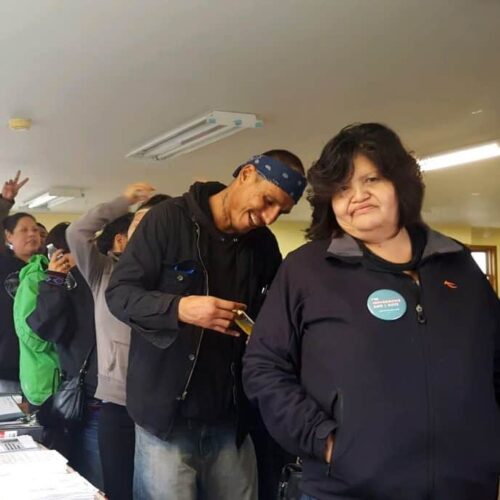Introduction
Turnout among Native American voters in North Dakota appeared to surge Tuesday, a striking display of muscle in the wake of a massive and unprecedented campaign to get Native American voters to the polls.
The effort followed a U.S. Supreme Court decision last month that allowed state voter identification requirements to go into effect for the general election.
Tribes scrambled to issue thousands of free identification cards and nonprofits raised hundreds of thousands of dollars to support canvassing and get-out-the-vote efforts on the state’s Native American reservations, including transporting people to the polls Tuesday. Actor Mark Ruffalo, the Dave Matthews Band and Billy Ray Cyrus last week joined Native American performers for a star-studded series of events on North Dakota reservations meant to promote voting.
The effort wasn’t enough to re-elect U.S. Sen. Heidi Heitkamp, a Democrat, who lost her seat to U.S. Rep. Kevin Cramer, a Republican, despite winning big majorities in the state’s three counties where Native Americans make up a majority of the population.
Sioux County, the North Dakota side of the Standing Rock reservation, which spans North and South Dakota, turned out 1,423 voters for the midterm election according to unofficial results released by the North Dakota secretary of state, a 52.47 percent turnout — the highest since at least 2008, a presidential election and more than double the 694 voters who came out for the 2014 midterm elections.
Two other counties with majority Native American populations also reported booms in voter turnout, unofficial results show.
Benson County, home to much of the Spirit Lake reservation, reported 2,288 ballots cast, a presidential election-level turnout, and Rolette County, home to the Turtle Mountain reservation, reported 5,102, the highest in at least a decade, according to turnout data available through the North Dakota secretary of state’s website and OJ Semans, co-executive director of Four Directions, a South Dakota-based nonprofit that helped direct voter turnout efforts on the reservations.
On the Turtle Mountain reservation, about 70 people marched to a polling place chanting, “North Dakota, you can’t do that,” a reference to the voter identification law.
Observers reported mostly smooth sailing at the polls, with some hitches.
For example, Standing Rock Sioux tribal officials were scrambling Tuesday morning to issue new tribal identification cards to three people who said they were turned away from the polls in Fort Yates because the addresses on their identification read “Avenue” instead of “Street.”
The new identification cards were issued. All three voted, said Danielle Finn, director of external affairs of the Standing Rock Sioux Tribe.
In Sioux County, at least, the turnout surge appears to have been somewhat larger than election officials anticipated, despite freezing temperatures and snowy weather on Election Day.
Finn and Matthew Samp of Four Directions said the tribe asked Sioux County Auditor Barbara Hettich to order additional ballots for a larger than usual turnout, but hadn’t gotten a response.
Matthew Samp of Four Direction said that at one point Tuesday, two voters from Cannon Ball, North Dakota, went to a countywide voting site in Fort Yates, North Dakota, and were told there were no ballots left. They were told would have to vote in Cannon Ball, at a site about half an hour away, according to Samp.
Meanwhile, an hour and a half before the polls closed Tuesday, Annie Red Tomahawk, a poll worker at a voting site in Porcupine, North Dakota, said by phone the polling site had eight ballots remaining and she had called out for more, anticipating an after-work surge. The voting site in Cannon Ball, near the reservation’s border, also ran short.
Also reached by phone, Sioux County Auditor Barbara Hettich, who oversees elections, said she had arranged to send additional ballots to both sites, and the request for additional ballots had come in too late for her to comply.
Tribal officials have spent the past two weeks issuing thousands of new tribal identification cards to meet the state’s voter ID requirements, which mandate voters have an ID with a residential street address. Many people on the reservations lack that because post office boxes are commonly used for mail, and directions typically rely on landmarks. In many cases, people needed residential addresses assigned to them.
U.S. District Judge Daniel Hovland last week declined to grant emergency relief from the requirements in a lawsuit brought by the Spirit Lake Tribe, ruling that granting an injunction days before the election “will create as much confusion as it will alleviate.”
But Hovland also said the allegations in the lawsuit “give this court great cause for concern,” and the litigation over the requirements and how they are applied is likely to continue.
Generally, observers on the state’s reservations said the voting process went smoothly, and tribal members were able to cast their votes using tribal identification.
“The best outcome that could have happened would be to have this big voter turnout,” Finn said. “People who are older than the age of 50 years old voted for the first time. To me, that’s outstanding. No matter what they were not going to be further oppressed.”
But Danielle Lang, a lawyer for the Campaign Legal Center who represents the plaintiffs in last week’s lawsuit, said that was only true because the tribes did “an extraordinary job.”
“I can imagine any number of officials coming forward and saying, ‘Oh look, there weren’t that many problems with Native Americans being able to vote,’ but that’s really very disingenuous,” she said. “The only reason these people were able to vote was because the tribes stepped in and took it on at enormous cost to themselves. They’re not going to be able to do this for every election.”
Read more in Money and Democracy
Abandoned in America
Mississippi’s education department takes over Yazoo City schools
Move follows Center for Public Integrity’s investigation into the failing school district




Join the conversation
Show Comments